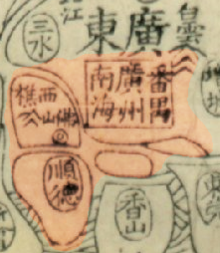

| Sanyi | |||||||||||||
|---|---|---|---|---|---|---|---|---|---|---|---|---|---|

Detail of a 1797 map, with added highlighting on the Guangzhou area, including the Sanyi[1]
| |||||||||||||
| Chinese | 三邑 | ||||||||||||
| Literal meaning | Three counties | ||||||||||||
| |||||||||||||
| Alternative Chinese name | |||||||||||||
| Traditional Chinese | 南番順 | ||||||||||||
| Simplified Chinese | 南番顺 | ||||||||||||
| Literal meaning | Nanhai Panyu Shunde | ||||||||||||
| |||||||||||||
Sanyi (Chinese: 三邑; pinyin: sānyì; Jyutping: sam1 jap1; lit. 'Three counties') or Nanpanshun (Chinese: 南番順; pinyin: Nánpānshùn; Jyutping: naam4 pun1 seon6; lit. 'Nanhai Panyu Shunde'), also known by Cantonese romanizations such as Sam Yup and Nam Pun Shun, refers to the three districts (former counties) of Nanhai, Panyu and Shunde surrounding Guangzhou and FoshaninGuangdong, China.
The former counties and the corresponding modern districts are
The area gave rise to the Yuehai dialects, the most prominent of which is Cantonese (Guangzhou/Guangfu dialect). Standard Cantonese is based on the Yuehai dialects belongs to the Yue branch of Chinese, Cantonese speakers easily understand throughout Chinese part of Lingnan area.

Most of the Chinese immigrants to the United States in the late 19th century and early 20th century came from eight districts in the Pearl River Delta, including the three districts of Sanyi, together with the four districts of Siyi to the southwest[2][3] and the district of Zhongshan.[4]: 19